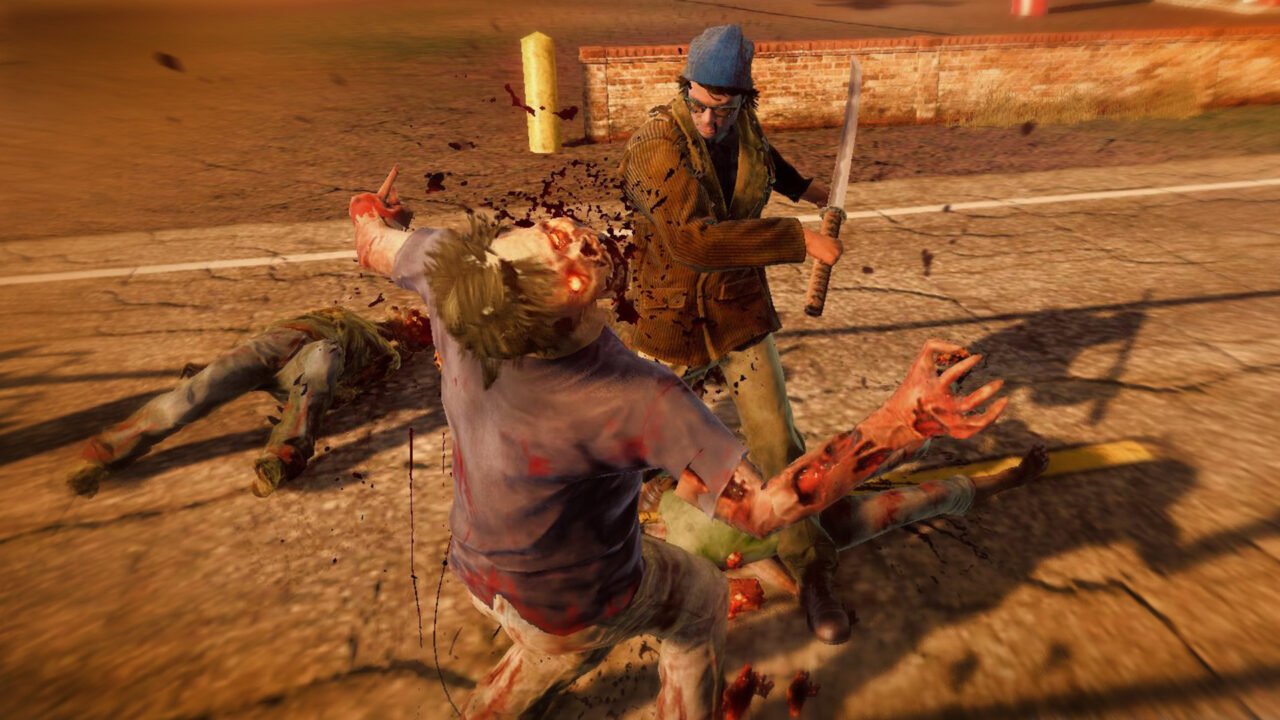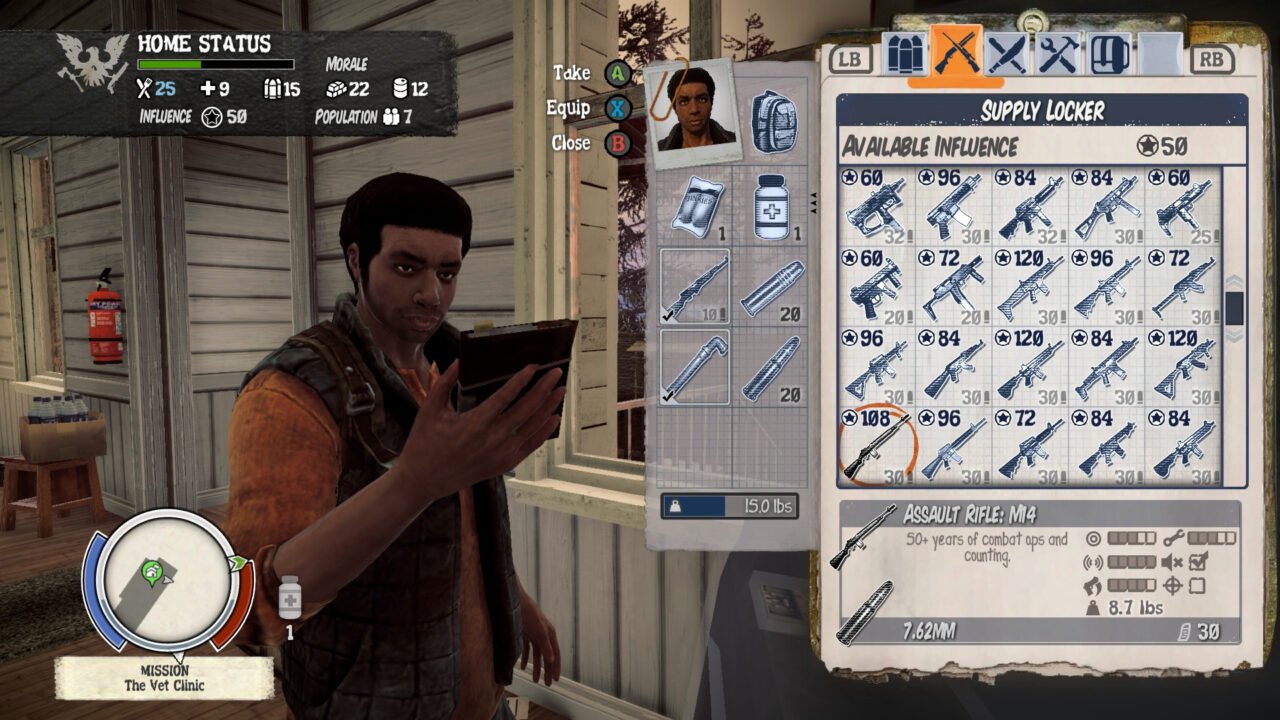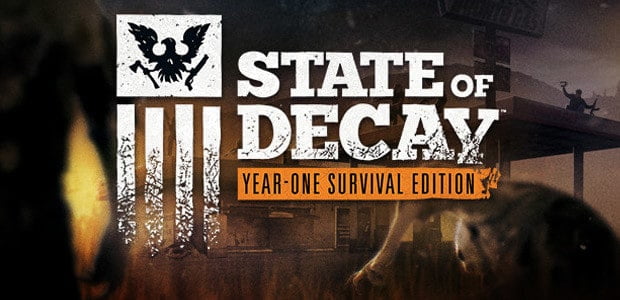State of Decay represents a meeting of two strands of the zombie outbreak of video games. You have the recently discussed Dying Light or Dead Rising which want nothing more than to allow as much zombie brutality as possible. The other strand takes a more pragmatic view on the apocalypse. A Rebuild or 7 Days to Die might involve the re-killing of zombies, but equal importance is placed on staying alive yourself, and perhaps battling the humans which still plague the world. State of Decay takes both – the real-time head stomping and thoughtful resource management – and makes something wholly unique. It’s a game which blends both well enough to not be a failure, and at the time was something I heralded as a trailblazer in its niche, and on return may have more vigour in concept than in execution, feebly fighting with an abundance of bugs, lacklustre strategic elements and well intentioned yet counterintuitive gimmicks.
The tranquil getaway of buddies Marcus and Ed is cut swiftly short, as State of Decay drops us right into the thick of things with an immediate wrestling match between a few zombies. Chowing down on our dazed duo, we fight back, pummeling them with a stray rotten branch, perhaps caving in a head or two as we swing haphazardly and ponder: what the fuck is going on? We travel further into a small outpost on the border of Trumbull Valley looking for answers, only to be met with more undead. We eventually fumble our way deeper into the province, meeting a few key survivors on the way and attempting to make sense of the incipient outbreak. Survival is key, and while answers remain locked behind doors, we find ourselves lacking in resources: food, medicine and ammo. Enter, State of Decay’s entire being. Scavenge for supplies, bash some zombie skulls in, and uncover the truth behind Trumbull Valley’s tumble into terror.
I played State of Decay YOSE, “Year One Survival Edition”, predominantly an ever-so-slightly remastered version of the original Xbox 360 release. Playing on the Series X, it’s apparent that it’s a 360 title, and as both memory and recent experience proved to me, the YOSE additions clearly did very little to make it appear any differently. It’s not that State of Decay looks bad per say, just very… 360-y: blurry, bloomed contrast and, in motion, a 30fps lock which screams of 7th generation gaming. Otherwise, the game looks fine, predominantly down to the style attempted, a half step into the land of cartoon while retaining a certain degree of grit and realism. It matches the tone well too. State of Decay never takes itself too seriously, not really camp, but not poe faced by any means, cracking jokes occasionally and utilising animations which emphasise a wacky side to the zombies in particular. Texture quality is, as I say, fine, when they decide to appear. Unfortunately, it’s a game which suffers from dreadful pop in, so much so that it tangibly affects gameplay, occasionally failing to render wrecked cars and signs before you pummel into them.
It’s not a massive problem for the most part, as most of your time is spent on foot, face to face with the undead rather than behind the comfort of steel machines. State of Decay’s combat, while limited and primitive, excels as conveying weight and oomph through emotive animations and manipulating their speed. Bashing X will swing at zombies in expected fashion, and until a character learns a few moves, there’s very little variation between smashing X until you take them down and pressing Y to finish them off. For such little complexity, it’s incredible how much the animation lifts the entire feeling of combat. Hitting zombies with a certain weapon is often accompanied by the appropriate “donk” of an iron bar or “pfft” of a 2×4. Finished moves like the classic “swing at the zombies head like a gold drive” may slow down halfway through, giving this sensation of charging up, releasing a mist of red when the motions reels towards their heads. It’s fascinating that it could be perceived as laggy almost, but that’s part of why it works ultimately, favouring style over substantive depth and working for the style of game it is. That’s not to say I wouldn’t have welcomed greater depth, because even a fully levelled character will only ever learn two extra moves, of which you’ll likely only ever use one of them.

You can’t wail on zombies infinitely, though. As you’d expect, you have limited stamina, and in State of Decay, “stamina” refers to two related concepts. After a while – twenty, twenty five minutes or so – your character will tire, reducing their max stamina, a bar which defines how long you can attack and spring for, slowly recharging without the aid of support items. You really want to tag out when fatigue strikes, as stamina is a resource far more important than any of the survival supplies you need to scavenge. The biggest problem arises when you factor in the real-world time element, a mechanic which affects more than just stamina, but in this case, it requires you wait a certain amount of time (around the same amount of time a character can last without becoming tired) until that character is rested. The biggest issue this presents is linked to how the game handles protagonists, by which I mean it doesn’t. While you start the game as Marcus and Ed, you almost immediately can switch out to another survivor in your camp. The starter duo have specific dialogue for the first fifteen minutes of the game, but beyond that, the game treats the character you’re currently playing as a sort of vessel for the player itself, disregarding the fact what they’ve individually experienced and know as a character isn’t what characters like Marcus or Ed should have experienced or known.
The relationship between stamina and switching out is most evident due to the way levelling works. Each character has certain stats, some character specific, some unique skill trees. Fighting, cardio and wits are generic and all extremely useful to everything you do in the game, which means when the buffed character you’ve been playing with gets exhausted, you have to swap out to some scrawny, bumbling pleb who probably would have trouble surviving in a society with or without flesh eating monsters. As a result, getting attached to a certain character is pointless, as most of the time, you won’t get a chance to play as them anyway, sidelined due to a mobile-esque time system which doesn’t account for narrative or character association. I might as well put “narrative” in quotes for that matter, as the lack of a main character – or even character at all, the game treats all playable characters the same – means progression of any sort of story feels detached from the people you play as. You meet scripted characters (more like caricatures) on the way who verbalise lengthy speeches, and your current character always, almost comically, replies with blunt, generic sentences, because they literally, by design, have no personality. Well, the game has a system for personality traits, but due to the constant swapping of characters, you never learn anything about anyone. Actually, I know something about Maya. I know she got torn to shreds and died permanently on my playthrough because I saw it in spectacular fashion. Everyone else? Cardboard cutouts.

Even if the game scaled back and had a handful of somewhat developed characters, the game never proves itself competent at conveying witty dialogue or emotional scenes, and I feel it would be a wasted effort at the end of the day. When the game isn’t eerily quiet – music, on the same level as its visual counterpart, is functional and fine – your current character and Lily, the radio operator, will exchange occasional mundane dialogue, of which went in one ear and came right back out the other. Missions very rarely stray from the formula of “go to x, listen to a diatribe, leave area”, and the narrative thrust of revealing the truth behind the outbreak is so routine and told in such a glacially slow pace I couldn’t pretend to care.
I knew most of this going back into the game though, and as my intro alluded to, I’ve always viewed State of Decay as a blend of genres, and while the more manifest combat encounters hold up in their simplicity, the scavenging elements fails to provide the depth or difficulty needed to be worth including. There are a few resources that need to be maintained, fuel and building materials, in addition to the former three mentioned earlier on, and yet again, the real-world time element rears its ugly head here too. Resources slowly decline over actual time, and it’s an actual waste of time including it, as in my weeklong playthrough, I was never below even a surplus of supplies, let alone running low. Your base of operations can only hold so much stock, yet the world is crammed with houses, offices, lots and shops filled with all manner of goodies. It only takes a couple of supply runs to fill all five categories to full, and from that point, bar building materials, they never really decay. The sad thing is, I quite like the act of scavenging here, which again has the laughably simple “hold Y to loot” mechanic which actually works. First you enter a building, scope it out for zombies. Once clear certain objects can be searched, and holding Y will do so slowly according to your wits skill, and holding LB will additionally speed up the process at the risk of making noise loud enough to draw entire hordes upon you. I don’t know why it works, a glorified QTE, but it does, a cathartic experience watching the search wheel come to a close and build a miniscule amount of experience in your wits skill. If only it served a purpose, as the game is just too easy to even require the need to scavenge at all.
I highlighted building materials as the sole resource which will need regular replenishment as is the resource which naturally dictates building and upgrading your base. Every potential base location has requirements: bigger ones need more people to uphold it while smaller ones require fewer, but suffer with fewer utility spots. You can choose to build areas for beds, healthcare, agriculture and more, and despite never feeling necessary, it’s easily the better part of State of Decay’s strategic side, offering avenues of diversity in how you build your settlement. Alas, time. Humanity’s greatest threat strikes again, and building new amenities requires not only the building supplies, but also the patience of the player, sometimes asking them to wait several hours for their completion. State of Decay was released on the Xbox 360, folks, not fucking mobile.
I don’t hate State of Decay. Ambitions aside, there are still elements to it that work. The 7th generation of console gaming is both a beautiful and ugly period in gaming, on a purely aesthetic front. While it runs less than ideally, is infested with more bugs than it is zombies and looks like someone dropped vaseline on my TV when I play it, Trumbull Valley is still an endearing location, with soothing sunsets spliced with the calming imagery of half-serious zombie mutilations. It’s a fun game to play in spurts, and broken up into smaller sessions, you can avoid some of the problems which arise through the terrible mobile-inspired design decisions. It’s not flawless, and unlike what I may have thought back in the day, I don’t even think I’d call it good. But it is interesting and playable. If you’re not sick of zombies, then you’ve probably already played it. This review means nothing in 2022.

